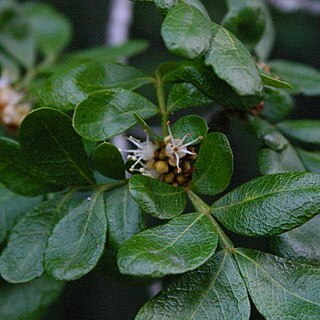A small to medium sized tree. It is usually 3-9 m tall and slender. The trunk is 15-20 cm across. The leaves are alternate and compound. There are 3-6 pairs of leaflets. These are oval and 0.8-5 cm long and almost opposite. The midrib is winged. They are usually unequal-sided and narrow to the base. The flowers are small and yellow. They are in short velvety panicles in the axils of leaves. The fruit is round and the size of a pea. The seed is black.
Monoecious or polygamous, aromatic, small tree to 5 m, velvety on young parts. Leaves paripinnate, rachis winged, leaflets obovate, toothed above, margins slightly revolute. Flowers in axillary panicles, golden velvety. Fruits globose.
Tree, up to 5 m high. Leaves pinnate, leaflets suboppo-site, margins entire, serrate or toothed, reflexed. Flowers in dense panicles; red.


